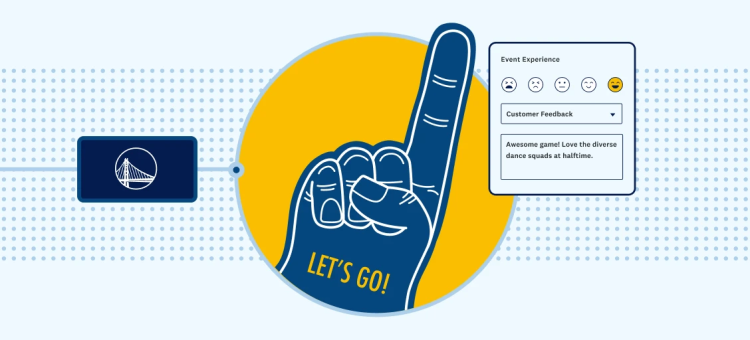As any team member knows, there’s a rhythm to every project. From conception to closure, a project lifecycle typically involves multiple phases—and you may flex different skills, deal with different stakeholders, and focus on different deliverables during each one.
The thing about these phases is that they’re all vital to a project’s success. And because they’re so intertwined, there’s no need to limit yourself to post-project surveys. While after-the-fact surveys, like customer satisfaction or event feedback, are great ways to gauge impact, there are lots of other ways to leverage surveys throughout a project lifecycle.
We’ll walk you through how surveys can naturally and effectively fit into all the phases of your team’s projects. When you take advantage of these survey opportunities, you’ll gain more insights, make better decisions, and connect with team members and stakeholders more easily.
Let’s look at a typical project lifecycle
While no two projects are identical, you probably go through a similar process each time. Let’s say, for instance, you’re introducing a new product. The phases in that project lifecycle might go something like:
- Conception: Your team focuses on figuring out what your current and prospective customers’ preferences are and whether they will be interested in buying your new product.
- Alignment: You connect with stakeholders to better understand their concerns and motivations. With these insights, your team makes a case for why the new product will benefit the business, establishes the project scope, and secures the resources or budget you need.
- Launch: You work closely with your marketing and sales teams to present the product in the most effective way possible. In this phase, you also might conduct some competitive analysis to learn how to attract your customers better.
- Post-launch: Once you finish celebrating your launch, you work on understanding how satisfied customers are with this new product. This is also when you check in with your stakeholders about what went well and what could be improved for the future success of your business.
In this example, if you’re only surveying in the post-launch phase—like asking for feedback via a customer satisfaction survey—then you’re missing out on lots of juicy insights that could benefit this project and your entire team.
Keep in mind, going beyond post-project surveys doesn’t mean you and your team are signing on for a ton of extra work. The surveys you send at each phase of a project can be short and sweet and still generate major insights.
Reimagine how you use surveys in your project lifecycle
Revamping how and when you use surveys in your projects can make a huge difference for productivity, communication, and impact—especially if you currently only use surveys at the end of a project.
If your work is very team-driven and cross-functional collaboration is key to your success, you can boost how everyone works together by integrating surveys into your entire project lifecycle. Get inspired with these ideas:
Validate ideas and priorities
Running surveys early on in your project will allow you to validate your ideas and solidify next steps. Sticking with our product launch example above, you could run a survey in the conception phase to learn whether this new product resonates with your customers. This will also help your team get a clearer understanding of customers’ unmet needs, pain points, barriers to purchase, and ideal price point.
Plus, this kind of research will be valuable when you’re ready to sync with stakeholders—you may even want to spotlight your results by presenting your data in a customized dashboard. If some stakeholders want to get hands-on with your survey results, consider giving them Contributor seat access so they can dig into the details of customer perception.
Cater to your stakeholders
Speaking of stakeholders, surveys can help you ace the alignment phase of any project. Before presenting your product pitch, you could run a quick survey to find out exactly what will speak to stakeholders the most. What do they want to learn? What are their concerns? What are they most excited about? Invite teammates to comment on the results so you can tailor your presentation ahead of time and make sure you can respond to any lingering questions.
Tap into your loyal customer base
As long as you’re aligning on the scope of your proposed new product, don’t overlook some of the most important voices: your most loyal customers. Use a survey to ask for their input about the product, including what they love, what’s missing, and how they see it fitting in with their standard purchases.
Sync with your team
The launch phase of a project can often get hectic, and it’s always helpful to check in with your team. You could survey them to gather creative ideas on how to spread the word about the new product to both internal teams and customers. Or, use a survey to find out whether your sales team has any specific questions about how you’re positioning the product.
You could also use a pre-launch survey to make sure your SurveyMonkey team plan is working for your team. Do they wish they had a different access level? Have they been dying to get more people to work on analysis? Getting these answers will not only reveal better ways for team Admins to leverage team seats, it’ll also shed light on the overall challenges your team has faced during this project—like process bottlenecks or an unbalanced workload.
Think beyond customer satisfaction
Once you’ve hit the post-launch phase of your project, a customer satisfaction survey is a natural next step. But your external post-project surveying doesn’t have to end there. You could also take this time to ask customers how they feel your product performs compared to competing products, so you can get fresh ideas for improvements and start planning your next great iteration.
Circle back with stakeholders
You can also get a lot out of measuring internal satisfaction after your product launch. Collect feedback from stakeholders and teammates on what they view as the next milestone for your new product, what worked well during the launch, and what could have gone more smoothly. This sort of retrospective survey is a helpful and efficient way to close the loop and improve processes for everyone involved.
Interview and spotlight your major contributors
Closing out this product launch example, you could use a survey to get an inside look at the people and work behind your new product. Ask some key stakeholders or collaborators to answer a few questions about how they built it, what need you were filling, or the creative process behind the design. You can then quote those folks on social media, in promotional campaigns, or even in your internal Slack channels. This is a great way to highlight all their hard work and spark fun conversations about your latest innovation.
A product launch is just one example of how you can establish a holistic project lifecycle that’s fueled by insights at every level. We hope these ideas help you envision new ways for your team to incorporate surveys throughout your projects.



